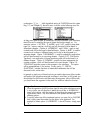
Page 3-7
the inverse trigonometric functions represent angles, the answer from these
functions will be given in the selected angular measure (DEG, RAD, GRD).
Some examples are shown next:
In ALG mode:
„¼0.25`
„¾0.85`
„À1.35`
In RPN mode:
0.25`„¼
0.85`„¾
1.35`„À
All the functions described above, namely, ABS, SQ,
√, ^, XROOT, LOG,
ALOG, LN, EXP, SIN, COS, TAN, ASIN, ACOS, ATAN, can be combined with
the fundamental operations (+-*/) to form more complex
expressions. The Equation Writer, whose operations is described in Chapter 2,
is ideal for building such expressions, regardless of the calculator operation
mode.
Differences between functions and operators
Functions like ABS, SQ, √, LOG, ALOG, LN, EXP, SIN, COS, TAN, ASIN,
ACOS, ATAN require a single argument. Thus, their application is ALG mode
is straightforward, e.g., ABS(x). Some functions like XROOT require two
arguments, e.g., XROOT(x,y). This function has the equivalent keystroke
sequence ‚».
Operators, on the other hand, are placed after a single argument or between
two arguments. The factorial operator (!), for example, is placed after a
number, e.g., 5~‚2`. Since this operator requires a single
argument it is referred to as a unary operator. Operators that require two
arguments, such as + - * / Q, are binary operators, e.g.,
3*5, or 4Q2.
Real number functions in the MTH menu
The MTH (MaTHematics) menu include a number of mathematical functions
mostly applicable to real numbers. To access the MTH menu, use the keystroke


















